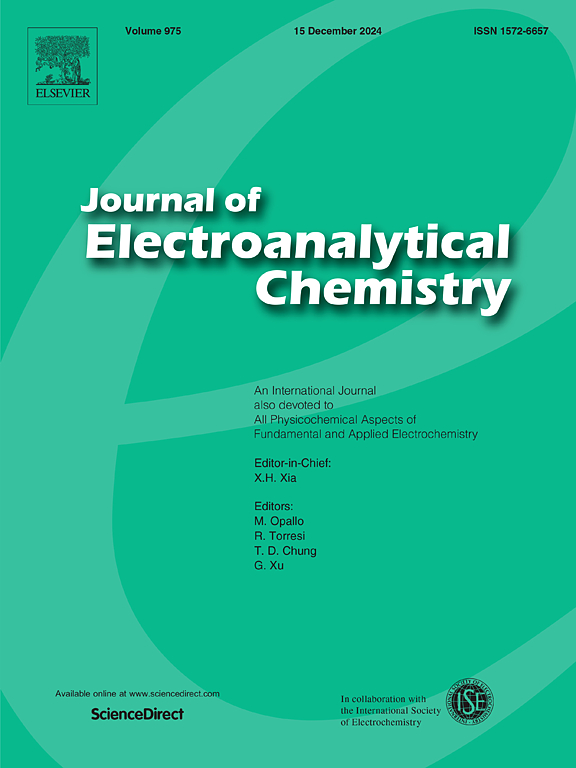基于层状磷酸钒的阴极材料的互钙化设计,以实现高性能水性锌离子电池
IF 4.1
3区 化学
Q1 CHEMISTRY, ANALYTICAL
引用次数: 0
摘要
锌离子水电池(AZIBs)具有理论能量密度高、成本低、环保和安全性高等优点,因此备受关注。在各种正极材料中,具有层状结构的磷酸钒(VOPO4)因具有较高的锌储存能力而展现出巨大的潜力。然而,由于其内在导电性较差,且在循环过程中结构会发生退化,因此总是导致 Zn2+ 扩散系数较低,可逆性较弱。在此,通过简单的溶热反应将 K+ 插层到 VOPO4 的夹层中,设计出了一种新型磷酸二氢钾(KVOPO4)阴极材料。得益于独特的层状结构和插层效应,KVOPO4 电极表现出较大的放电容量和更高的循环稳定性(400 次循环后,1 A/g 时为 153.2 mAh g-1),以及出色的速率能力(5.0 A/g 时为 119.4 mAh g-1)。该电极还具有伪电容控制存储行为,在 0.8 mV/s 时的贡献率高达 98%。此外,还进行了原位 XRD 和 XPS 研究,以证明 Zn2+ 插入/萃取过程中的相关相变,从而揭示 KVOPO4 的可逆 Zn 储存机制。这项工作有望丰富基于 VOPO4 的阴极材料的设计策略,并为探索高性能 AZIBs 的储能应用铺平道路。本文章由计算机程序翻译,如有差异,请以英文原文为准。
Intercalation design of layered vanadium phosphate based cathode material towards high-performance aqueous zinc-ion batteries
Aqueous zinc-ion batteries (AZIBs) have attracted significant attention because of high theoretical energy density, low cost, environmental friendliness and high safety. Among various cathode materials, vanadium phosphate (VOPO4) with a layered structure exhibits huge potential due to high Zn-storage capacity. However, the poor intrinsic conductivity and structural deterioration during the cycling process always result in low Zn2+ diffusion coefficient and weak reversibility. Herein, a novel potassium vanadyl phosphate (KVOPO4) cathode material was designed by the intercalation of K+ into the interlayer of VOPO4 via a simple solvothermal reaction. Benefiting from the unique layered structure and intercalation effect, the KVOPO4 electrode exhibits large discharge capacity and enhanced cycling stability (153.2 mAh g−1 at 1 A/g after 400 cycles), and excellent rate capability (119.4 mAh g−1 at 5.0 A/g). The electrode also suggests a pseudocapacitance controlled storage behavior with high contribution percentage of 98 % at 0.8 mV/s. Besides, ex-situ XRD and XPS were conducted to demonstrate the related phase transitions upon the Zn2+ insertion/extraction process, revealing the reversible Zn-storage mechanism of the KVOPO4. This work is expected to enrich the design strategy of VOPO4-based cathode materials and pave the exploration of high-performance AZIBs towards energy storage applications.
求助全文
通过发布文献求助,成功后即可免费获取论文全文。
去求助
来源期刊
CiteScore
7.80
自引率
6.70%
发文量
912
审稿时长
2.4 months
期刊介绍:
The Journal of Electroanalytical Chemistry is the foremost international journal devoted to the interdisciplinary subject of electrochemistry in all its aspects, theoretical as well as applied.
Electrochemistry is a wide ranging area that is in a state of continuous evolution. Rather than compiling a long list of topics covered by the Journal, the editors would like to draw particular attention to the key issues of novelty, topicality and quality. Papers should present new and interesting electrochemical science in a way that is accessible to the reader. The presentation and discussion should be at a level that is consistent with the international status of the Journal. Reports describing the application of well-established techniques to problems that are essentially technical will not be accepted. Similarly, papers that report observations but fail to provide adequate interpretation will be rejected by the Editors. Papers dealing with technical electrochemistry should be submitted to other specialist journals unless the authors can show that their work provides substantially new insights into electrochemical processes.

 求助内容:
求助内容: 应助结果提醒方式:
应助结果提醒方式:


